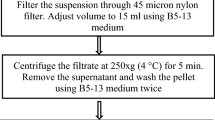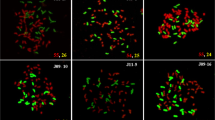Abstract
Genomic in situ hybridization (GISH) was used for a chromosomal composition study of the later generations of interspecific hybrids between A. cepa L. and A. fistulosum L., which are relatively resistant to downy mildew (peronosporosis). GISH revealed that F2 hybrids, which did not produce seeds, were triploids (2n = 3x = 24) with 24 chromosomes and possessed in their complements 16 chromosomes of A. fistulosum L. and eight chromosomes of A. cepa L. or eight chromosomes of A. fistulosum L. and 16 chromosomes of A. cepa L. The advanced F5 hybrid, which produced few seeds, was amphidiploid with 32 chromosomes. BC1F5 hybrid was triploid with eight chromosomes of A. fistulosum L. and 16 chromosomes of A. cepa L., which did not produce seeds. BC2 (BC1F5) plant was amphidiploid that possessed 4 recombinant chromosomes and produced few seeds. GISH results point to 2n-gametes formation in macro- and microsporogenesis of the hybrids. The mechanism of 2n-gametes formation and the possibility of apomixes events in the backcrossing progeny are discussed.
Similar content being viewed by others
References
Dong, F., Novy, R.G., Helgeson, J.P., and Jiang, J., Cytological characterization of potato-Solanum tuberosum somatic hybrids and their backcross progenies by genomic in situ hybridization, Genome, 1999, vol. 42, pp. 987–992.
Khrustaleva, L.I., Molecular cytogenetics in plant breeding, Izv. Timiryazevsk. S-kh. Akad., 2007, no. 1, pp. 45–55.
Gavrilenko, T., Larkka, J., Pehu, E., and Rokka, V.-M., Identification of mitotic chromosomes of tuberous and non-tuberous Solanum species (Solanum tuberosum and Solanum brevidens) by GISH in their interspecific hybrids, Genome, 2002, vol. 45, pp. 442–449.
Haider Ali, S.N., Ramanna, M.S., Jacobsen, E., and Visser, R.G.F., Establishment of a complete series of a monosomic tomato chromosome addition lines in the cultivated potato using RFLP and GISH analyses, Theor. Appl. Genet., 2001, vol. 103, pp. 687–695.
Ji, Y., Pertuzé, R., and Chetelat, R., Genome differentiation by GISH in interspecific and intergeneric hybrids of tomato and related nightshades, Chromosome Res., 2004, vol. 12, pp. 107–116.
Divashuk, M.G., Kroupin, P.Yu., Sloviev, A.A., and Karlov, G.I., Molecular cytogenetic characterization of the spring triticale line 131/7 carrying a rye-wheat translocation, Russ. J. Genet., 2001, vol. 46, no. 2, pp. 185–190.
Fradkin, M., Greizerstein, E., Paccapelo, H., et al., Cytological analysis of hybrids among triticales and trigopiros, Genet. Mol. Biol., 2009, vol. 32, no. 4, pp. 797–801.
Khrustaleva, L.I. and Kik, C., Cytogenetical studies in the bridge cross Allium cepa × (A. fistulosum × A. roylei), Theor. Appl. Genet., 1998, vol. 96, pp. 8–14.
Chuda, A. and Adamus, A., Hybridization and molecular characterization of F1 Allium cepa × A. roylei plants, Acta Biol. Cracov., Ser. Bot., 2012, vol. 54, no. 2, pp. 25–31.
Khrustaleva, L.I. and Kik, C., Introgression of Allium fistulosum into A. cepa mediated by A. roylei, Theor. Appl. Genet., 2000, vol. 100, pp. 17–26.
Hizume, M., Allodiploid nature of Allium wakegi Araki revealed by genomic in situ hybridization and localization of 5S and 18S rDNA, J. Genet., 1994, vol. 69, pp. 407–415.
Shibata, F. and Hizume, M., The identification and analysis of the sequences that allow the detection of Allium cepa chromosomes by GISH in the allodiploid A. wakegi, Chromosoma, 2002, vol. 111, no. 3, pp. 184–191.
Hou, A. and Peffley, E.B., Recombinant chromosomes of advanced backcross plants between Allium cepa L. and A. fistulosum L. revealed by in situ hybridization, Theor. Appl. Genet., 2000, vol. 100, pp. 1190–1196.
Khrustaleva, L.I., Kan, L.Yu., Kirov, I.V., and Sal’nik, A.A., Molecular and cytogenetic analysis of natural and synthetic Allium fistulosum sx A. cepa hybrids, Izv. Timiryazevsk. S-kh. Akad., 2010, no. 4, pp. 12–21.
Shigyo, M., Imamura, K., Iino, M., et al., Identification of alien chromosomes in a series of Allium fistulosum—A. cepa monosomic addition lines by means of genomic in situ hybridization, Genes Genet. Syst., 1998, vol. 73, no. 5, pp. 311–315.
Vu, H.Q., Yoshimatsu, Y., Khrustaleva, L.I., et al., Alien genes introgression and development of alien monosomic addition lines from a threatened species, Allium roylei Stearn, to Allium cepa L., Theor. Appl. Genet., 2012, vol. 124, no. 7, pp. 1241–1257.
Scholten, O.E., van Heusden, A.W., Khrustaleva, L.I., et al., The long and winding road leading to the successful introgression of downy mildew resistance into onion, Euphytica, 2007, vol. 156, pp. 345–353.
Jones, R.N., Cytogenetic evolution in the genus Allium, in Cytogenetics of Crop Plants, Swaminathan, M.S., Gupta, P.K., and Sinha, Eds., New York: MacMillan, 1983, pp. 516–554.
Currah, L. and Maude, R.B., Laboratory tests for leaf resistance to Botrytis squamosa in onions, Ann. Appl. Biol., 1984, vol. 105, pp. 277–283.
Netzer, D., Rabinowitch, H.D., and Weintal, C.H., Greenhouse technique to evaluate onion resistance to pink root, Euphytica, 1985, vol. 32, pp. 385–391.
Galván, G.A., Wietsma, W.A., Putrasemedja, S., et al., Screening for resistance to anthracnose (Colletotrichum glorosporioides Penz.) in Allium cepa and its wild relatives, Euphytica, 1997, vol. 95, pp. 173–178.
Emsweller, S.L. and Jones, H.A., An interspecifc hybrid in Allium, Hilgardia, 1935, no. 9, pp. 265–273.
Levan, A., The cytology of the species hybrid Allium cepa × fistulosum and its polyploidy derivates, Hereditas, 1936, no. 21, pp. 253–272.
Peffley, E.B. and Hou, A., Bulb-type onion itrogressants possessing Allium fistulosum L. genes recovered from interspecific hybrid backcrosses between A. cepa L. and A. fistulosum L., Theor. Appl. Genet., 2000, vol. 100, pp. 528–538.
Ershov, I.I. and Orekhovskaya, M.V., Resistance of some Allium L. species to false onion downy mildew, Tr. Prikl. Bot., Genet. Sel., 1968, vol. 11, no. 1, pp. 131–133.
Yur’eva, N.A. and Titova, I.V., Interspecific hybridization of onion, in Trudy po selektsii ovoshchnykh kul’tur (Transections on Vegetable Crop Breeding), Moscow, 1980, no. 12, pp. 98–104.
Metodicheskie ukazaniya po selektsii lukovykh kul’tur (Methodical Guidelines on Onion Crop Breeding), Moscow, 1997.
Rogers, S.O. and Bendich, A.J., Extraction of DNA from milligram amounts of fresh, herbarium and mummified plant tissues, Plant Mol. Biol., 1985, vol. 5, pp. 69–76.
Pijnacker, L.P. and Ferwerda, M.A., Giemsa C-banding of potato chromosomes, Can. J. Genet. Cytol., 1984, no. 26, pp. 415–419.
Meinkoth, J. and Wahl, G., Hybridization of nucleic acids immobilized on solid supports, Anal. Biochem., 1984, vol. 138, pp. 267–284.
Kalkman, E.R., Analysis of the C-banded karyotype of Allium cepa L. standard system of nomenclature and polymorphism, Genetics, 1984, vol. 65, pp. 141–148.
de Vries, J.N., Onion chromosome nomenclature and homoeology relationships-workshop report, Euphytica, 1990, vol. 49, pp. 1–3.
Reeves, A. and Tear, J., Micromeasure for Windows, Version 3.2, Free program distributed by the authors, 1999. http://www.colostate.edu/depts/biology/micromeasure
Jones, R.N. and Rees, H., Nuclear DNA variation in Allium, Heredity, 1968, no. 23, pp. 591–605.
de Vries, J.N. and Jongerius, M.C., Interstitial C-bands on the chromosomes of Allium species from the section cepa, in Proceedings Eucarpia 4th Allium Symposium, Riggs, T.J., et al., Eds., Wellesbourne: Institute of Horticultural Research, 1988, pp. 71–78.
Ulloa, G.M., Corgan, J.N., and Dunford, M., Chromosome characteristics and behaviour differences in Allium fistulosum L., A. cepa L., their F1 hybrid and selected backcross progeny, Theor. Appl. Genet., 1994, vol. 89, pp. 567–571.
Maeda, T., Chiasma studies in Allium fistulosum L., Allium cepa L. and their F1, F2 and backcross hybrids, Japn. J. Genet., 1937, vol. 13, pp. 146–169.
Poulsen, N., Chives (Allium schoenoprasum), in Onions and Allied Crops, Brewster, J. and Rabinowitch, H., Eds., Boca Raton: CRC Press, 1990, vol. 3, pp. 231–250.
Kojima, A. and Nagato, Y., Pseudogamous embryogenesis and the degree of parthenogenesis in Allium tuberosum, Sex. Plant Reprod., 1992, vol. 5, pp. 79–85.
Stevenson, M., Armstrong, S.J., Ford-Lloyd, B.V., and Jones, G.H., Comparative analysis of crossover exchanges and chiasmata in Allium cepa × fistulosum after genomic in situ hybridization (GISH), Chrom. Res., 1998, vol. 6, pp. 567–574.
Kravets, E.A., Cytomixis, its nature, value and the cytological consequences, Cytol. Genet., 2012, no. 3, pp. 75–85.
Cheng Kuo-Chang, Nien Hsiu-Wan, Yang Chin-Lan, et al., Light and electron microscopical observations of its relation to variation and evolution, Acta Bot. Sin., 1975, no. 3, pp. 60–69.
Yang Jun, Y.U., Chun-Hong, Wang Xin-Yu, and Zheng Cuo-Chang Cheng, K.G., Ultrastructural observation on the intra- and intercellular microtrabecullar network of the pollen mothe cells in onion (Allium cepa), Acta Bot. Sin., 2001, vol. 43, no. 4, pp. 331–338.
Badaev, N.S., Badaeva, E.D., Dubovets, N.I., et al., Formation of a synthetic karyotype of tetraploid triticale, Genome, 1992, vol. 35, no. 2, pp. 311–317.
Author information
Authors and Affiliations
Corresponding author
Additional information
Original Russian Text © M.V. Budylin, L.Yu. Kan, V.S. Romanov, L.I. Khrustaleva, 2014, published in Genetika, 2014, Vol. 50, No. 4, pp. 443–451.
Rights and permissions
About this article
Cite this article
Budylin, M.V., Kan, L.Y., Romanov, V.S. et al. GISH study of advanced generation of the interspecific hybrids between Allium cepa L. and Allium fistulosum L. with relative resistance to downy mildew. Russ J Genet 50, 387–394 (2014). https://doi.org/10.1134/S1022795414040036
Received:
Accepted:
Published:
Issue Date:
DOI: https://doi.org/10.1134/S1022795414040036




